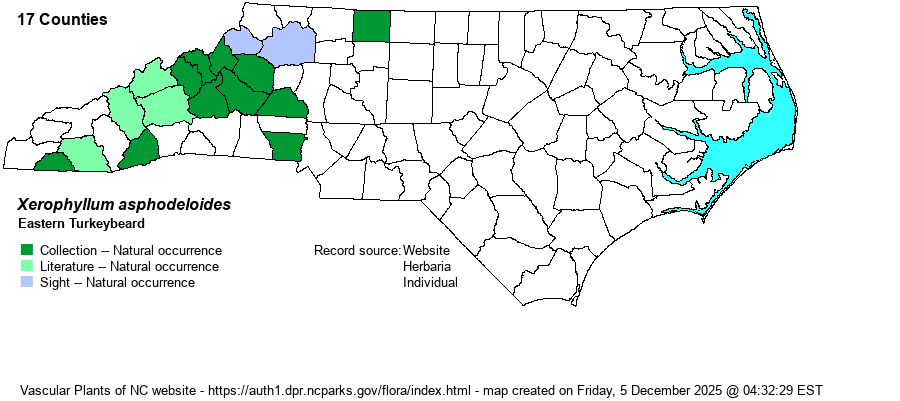| Author | (L.) Nuttall | |
| Distribution | Scattered across the Mountains and upper Piedmont (mostly on monadnocks and western ranges there). However, absent over most of the southwestern Mountains, and apparently absent from a few far northern Mountain counties. There are iNaturalist photos from Madison, Buncombe, Haywood, and Macon counties -- as long as the locations are not artificially misleading (which does happen for sensitive species). The distribution in the state is of disjunct occurrences.
This is primarily a Southern Appalachian species, but like a few others, it is disjunct to the Coastal Plain in NJ and DE. Otherwise, it occurs from northern VA and eastern WV south to northern GA and eastern AL. It does range sparingly eastward into the VA Piedmont.
| |
| Abundance | Rare to locally uncommon in the western Piedmont and adjacent edge of the Blue Ridge Escarpment, in a region from Wilkes and Catawba counties on the east to McDowell County and the TN line on the west. Very rare and local elsewhere, disjunct to Stokes and Gaston counties in the central Piedmont and to Clay and Transylvania counties in the southern Mountains. At one time it was on the NC NHP Watch List, but it was dropped from that list in recent years, even though it still is a scarce species (with an S3 State Rank). | |
| Habitat | Despite this being a vert showy and tall herbaceous species, one which would not look out of place in a rich hardwood forest, it grows in the exact opposite habitats. It is found essentially only on strongly acidic, rocky or otherwise xeric sites: Pine/Oak Heath stands, exposed bluffs, dry ridges, and open and dry roadbanks. These sites historically burned frequently. |
| Phenology | Blooms in May and June, and fruits in July and August. | |
| Identification | This is arguably the most stunning vascular plant found on xeric ridges and often exposed rocky sites in the foothills and lower mountains of the state. It is one of our few lilies that has evergreen leaves, with them existing as a basal rosette somewhat like a seedling Longleaf Pine (Pinus palustris). The grasslike leaves are up to 15 inches long, arching away from each other to form a clump that is 2.5-3 feet across when seen from above. The flowering stalk is quite tall, growing at least to 3 feet high, topped by a cluster of many dozens of small white flowers; the cluster can easily be several inches wide and 6 inches high. The only other similar plant is its "cousin" that grows in the Western states. The basal clump does resemble that of Longleaf Pine somewhat, though the leaves are a grayer or duller green than those of the pine, and of course that pine species does not grow in the mountains and foothills of the state, especially on rocky or xeric exposed sites. Normally, to see the species you probably need to visit a known location in a state park or in the Linville Gorge area, However, you can spot them in a few places along roadbanks that traverse the Blue Ridge Escarpment, especially along dirt roads where the roadbanks are not overly manicured/mowed. | |
| Taxonomic Comments | None
| |
| Other Common Name(s) | Beargrass (a name often given to Yucca species), Mountain-asphodel. "Turkeybeard" is often used, though as the Western species can also be named as Turkeybeard, the Eastern modifier name is preferred to avoid any confusion. | |
| State Rank | S3 | |
| Global Rank | G4 | |
| State Status | | |
| US Status | | |
| USACE-agcp | | |
| USACE-emp | | |

